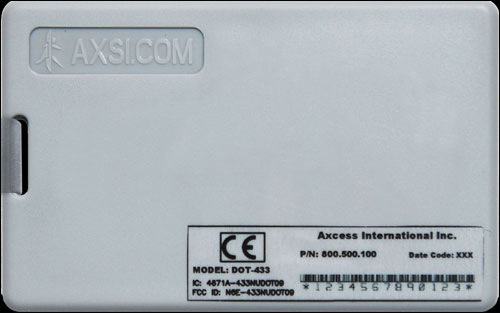An oil company that asked to remain unnamed has begun installing an RFID-based “Man-Down” monitoring and locating system on an oil-drilling platform in Malaysia. The firm plans to soon begin providing badges to its dozens of high-risk workers for each shift on the platform, to track when they become inactive, possibly indicating injury. Axcess International Inc. developed the system specifically for this customer, based on its own existing DotWireless technology, but is now offering it to other oil companies, as well as those in other industries, such as mining, says Axcess’ CEO, Allan Griebenow.
Axcess International offers wireless credential solutions to oil companies and other customers, and provides badges that employees can wear, as well as interrogators and software to interpret data from those badges, thereby allowing management to better track workers’ locations as they come and go during their shifts. Users can install portal readers, or use handheld interrogators, at such locations as mustering areas, in the event of a drill or emergency. In that way, companies can track when staff members arrive, where they are working, and when they report to a mustering area. In 2009, one of Axcess’ customers—the oil company with a platform in Malaysia—requested a better solution to track the status of its workers in high-risk jobs, thus allowing it to receive an automatic alert if an individual seems to have been injured.
The solution is what Axcess International calls the “Man-Down Monitoring and Locating” system, which combines a motion sensor with an active RFID tag to create a “MicroWireless Credential.” The security badge, which can clamp onto an item of clothing, stores a unique ID number linked to a staff member’s name, job title and other related data in a back-end software system provided by Axcess International. The tag can transmit at either 315 MHz or 433 MHz, and uses a proprietary air-interface protocol. To conserve battery power, Griebenow says, the badge remains dormant until it is activated by a 132 kHz signal from an exciter.
Griebenow declines to explain exactly how the oil company is using the system, but there are several options available. The software can instruct a tag to begin transmitting when a worker logs into the system, indicating he has arrived for his shift. It would then instruct the tag to go dormant when that person signs out at the end of that work period. A time clock could be input into the software, indicating when each staff member is working, and the tag could be activated at that time by an exciter installed at the employee’s work area. In another scenario, an exciter deployed at the entrance to a section of the platform, for example, could activate the tag of person as he reports to work, and the tag would then transmit until the end of the shift, when that individual again passes the exciter, which instructs the tag to cease transmitting.
While on the job site, the tag would beacon at regular intervals. The tag also receives information from the motion sensor, and determines whether that data should be filtered out if, for instance, the sensor’s data does not fall within parameters established to indicate a man is down. If the sensor data meets the criteria for a man-down alert, the tag sends that information with its transmission. Readers deployed around the platform receive the tag’s transmission, including the ID number and any data from the motion sensor, and forward that information to the back-end software via a cabled connection.
That software then translates the raw tag data into the worker’s identity and status, and also determines the badge’s general location, based on the reader’s location and the tag signal strength, as well as whether the employee’s status requires a response. The software can be programmed to issue an alert, for example, if the badge has remained motionless for a specified amount of time, such as five minutes. That alert can then be sent to company management via e-mail or text message.
Axcess International software also stores information for business reports, Griebenow says. For example, if an accident report is filed, the tag’s motion data can be accessed and printed to accompany that report. Axcess’ DotWireless system can be used in other ways as well, he notes, such as on assets. The tags can be programmed to detect either a lack of motion, as in the case described previously, or the presence of motion, such as the movement of a tag attached to an item that should not typically be moved. In addition, the tag can be provided with other sensors—such as temperature sensors and, in the future, shock sensors—which could help management determine how bad a fall was, based on the amount of impact.
“The system runs in the background,” Griebenow says. “There’s no labor required.” What’s more, it is designed not to require any effort on the part of badge-wearing staff members or management. “It’s an exception-based system,” he says, explaining that it remains in the background until detecting a problem. The system can be programmed to match the type of work being performed, so that those with very active and high-risk work, for instance, could have the system issue an alert if personnel remained motionless for a very short span of time.
The oil company adopting the system will soon provide the tags to employees, Griebenow says, and if all goes well, the firm intends to expand the system to additional oil platforms. In the meantime, he says, Axcess International has been speaking with some of its other oil-drilling clients about installing the man-down system on their offshore platforms. The system would also work well in mines, he indicates.


